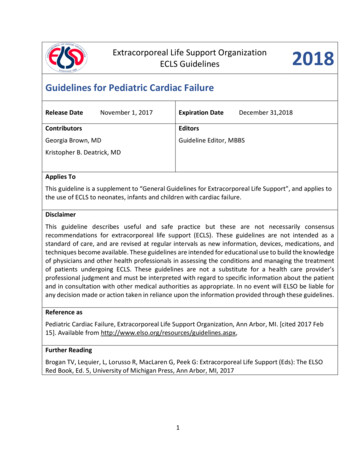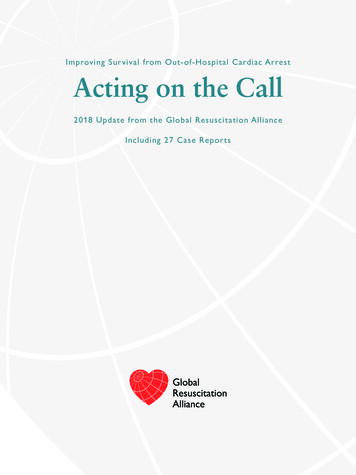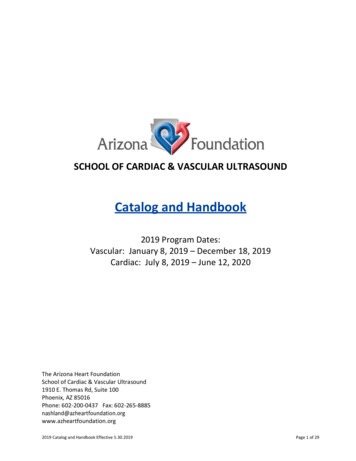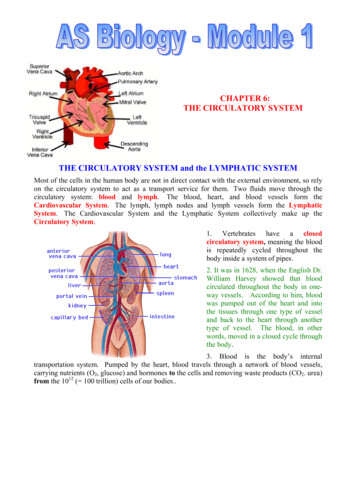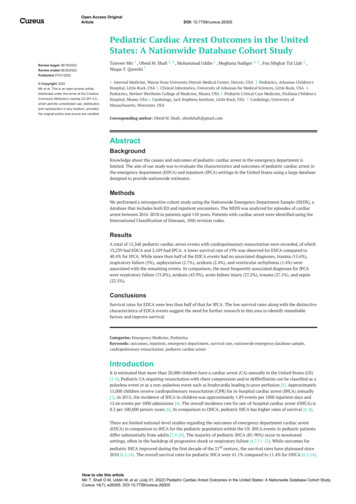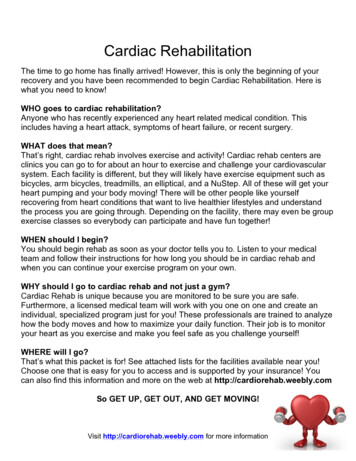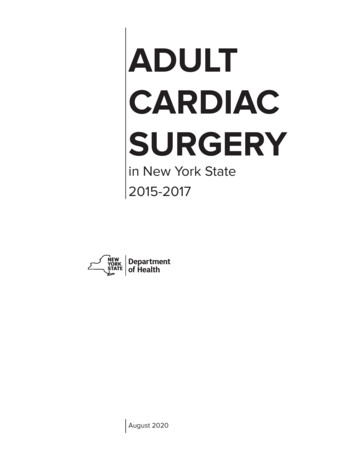
Transcription
ADULTCARDIACSURGERYin New York State2015-2017Departmentof HealthAugust 2020
Members of the New York State Cardiac Advisory CommitteeChairVice ChairSpencer King III, M.D.Professor of Medicine, EmeritusEmory University School of MedicineAtlanta, GAGary Walford, M.D.Associate Professor of MedicineJohns Hopkins Medical CenterBaltimore, MDMembersDavid Adams, M.D.Cardiac Surgeon-in-ChiefMarie-Josée and Henry R. Kravis Professor and ChairmanMount Sinai Health SystemIcahn School of Medicine at Mount Sinai and The MountSinai HospitalNew York, NYM. Hashmat Ashraf, M.D.Chief, Department of Cardiothoracic SurgeryKaleida HealthBuffalo, NYPeter B. Berger, M.D.Cardiology ConsultantFrederick Bierman, M.D.Director of Graduate Medical EducationWestchester Medical CenterValhalla, NYJoanna Chikwe, M.D.Professor and ChairDepartment of Cardiac SurgerySmith Heart InstituteCedars-Sinai Medical CenterLos Angeles, CAJeptha Curtis, M.D.Asst. Professor, Dept. of Internal Medicine (Cardiology)Director, Outcomes Research & Evaluation DataAnalytic CenterYale University School of MedicineYale-New Haven Hospital CenterNew Haven, CTLeonard Girardi, M.D.Chairman, Department of Cardiothoracic SurgeryCardiothoracic Surgeon-in-ChiefNew York Presbyterian HospitalWeill Cornell Medical CollegeNew York, NYJeffrey P. Gold, M.D.Chancellor, University of Nebraska Medical CenterUniversity of Nebraska - OmahaOmaha, NEAlice Jacobs, M.D.Professor of MedicineVice Chair for Clinical Affairs, Department of MedicineBoston University School of MedicineBoston Medical CenterBoston, MADesmond Jordan, M.D.Clinical Professor of Anesthesia, Division of CardiacAnesthesia and Critical Care MedicineNY Presbyterian Hospital – ColumbiaNew York, NYBarry Kaplan, MDAssistant Professor of MedicineNorthwell Hofstra School of MedicineManhasset, NYThomas Kulik, M.D.Director, Pulmonary Hypertension ProgramChildren’s Hospital BostonBoston, MAStephen Lahey, M.D.Chief, Division of Cardiothoracic SurgeryProfessor of SurgeryUniversity of Connecticut Health CenterFarmington, CTFrederick S. Ling, M.D.Professor of Medicine (Cardiology)University of Rochester Medical CenterRochester, NYRalph Mosca, M.D.Vice Chairman, Department of Cardiac SurgeryDirector, Congenital Cardiac SurgeryNYU Medical CenterNew York, NYRobert H. Pass, M.D.Chief of Pediatric CardiologyProfessor of PediatricsMount Sinai Kravis Children’s HospitalThe Icahn School of Medicine at Mount SinaiNew York, NYCarlos E. Ruiz, M.D., Ph.D.Professor of Cardiology in Pediatrics and MedicineDirector, Structural and Congenital Heart CenterHackensack University Medical CenterThe Joseph M. Sanzari Children’s HospitalHackensack, NJCraig Smith, M.D.Johnson & Johnson Distinguished ProfessorValentine Mott Professor of SurgeryColumbia University Medical CenterNew York Presbyterian HospitalNew York, NYThoralf Sundt, III, M.D.Chief, Cardiac Surgical DivisionCo-Director, Heart CenterMassachusetts General HospitalBoston, MAJacqueline Tamis-Holland, M.D.Senior Attending PhysicianMount Sinai St. Luke’sMount Sinai WestNew York, NYJames Tweddell, M.D.Surgical Director and Executive Co-DirectorThe Heart InstituteProfessor of SurgeryCincinnati Children’s Hospital Medical CenterCincinnati, OHFerdinand Venditti, Jr., M.D.Executive VP for System Care DeliveryHospital General DirectorAlbany Medical CollegeAlbany, NYAndrew S. Wechsler, M.D.Emeritus Professor, Cardiothoracic SurgeryDrexel University College of MedicinePhiladelphia, PAConsultantEdward L. Hannan, Ph.D.Distinguished Professor EmeritusDepartment of Health Policy, Management & BehaviorAssociate Dean EmeritusUniversity at Albany, School of Public HealthRensselaer, NY
Cardiac Surgery Reporting System SubcommitteeMembers & ConsultantsCraig Smith, M.D. (Chair)Johnson & Johnson Distinguished ProfessorValentine Mott Professor of SurgeryColumbia University Medical CenterNew York Presbyterian HospitalM. Hashmat Ashraf, M.D.Chief, Department of Cardiothoracic SurgeryKaleida HealthJoanna Chikwe, M.D.Professor and ChairDepartment of Cardiac SurgerySmith Heart InstituteCedars-Sinai Medical CenterLeonard Girardi, M.D.Chairman, Department of Cardiothoracic SurgeryCardiothoracic Surgeon-in-ChiefNew York Presbyterian HospitalWeill Cornell Medical CollegeJeffrey P. Gold, M.D.ChancellorUniversity of Nebraska Medical CenterUniversity of Nebraska - OmahaEdward L. Hannan, Ph.D.Distinguished Professor EmeritusDepartment of Health Policy, Management & BehaviorAssociate Dean EmeritusUniversity at Albany, School of Public HealthDesmond Jordan, M.D.Clinical Professor of Anesthesia, Division of CardiacAnesthesia and Critical Care MedicineNY Presbyterian Hospital – ColumbiaStephen Lahey, M.D.Chief, Division of Cardiothoracic SurgeryProfessor of SurgeryUniversity of Connecticut Health CenterRalph Mosca, M.D.Vice Chairman, Department of Cardiac SurgeryDirector, Congenital Cardiac SurgeryNYU Medical CenterRobert H. Pass, M.D.Chief of Pediatric CardiologyProfessor of PediatricsMount Sinai Kravis Children’s HospitalThe Icahn School of Medicine at Mount SinaiCarlos E. Ruiz, M.D., Ph.D.Professor of Cardiology in Pediatrics and MedicineDirector, Structural and Congenital Heart CenterHackensack University Medical CenterThe Joseph M. Sanzari Children’s HospitalThoralf Sundt, III, M.D.Chief, Cardiac Surgical DivisionCo-Director, Heart CenterMassachusetts General HospitalJames Tweddell, M.D.Surgical Director and Executive Co-DirectorThe Heart InstituteProfessor of SurgeryCincinnati Children’s Hospital Medical CenterAndrew S. Wechsler, M.D.Emeritus Professor, Cardiothoracic Surgery DepartmentDrexel University College of MedicineStaff to CSRS Analysis Workgroup –New York State Department of HealthOffice of Quality and Patient SafetyMarcus Friedrich, M.D., M.B.A.Chief Medical OfficerJeanne Alicandro, M.D.Medical DirectorCardiac Services ProgramKimberly S. Cozzens, M.A.Program DirectorAshraf Al-Hamadani, M.D., M.P.H.Clinical Review CoordinatorDiane Fanuele, M.S.Clinical Data CoordinatorLori FrazierProject AssistantJessica KincaidQuality Improvement Project CoordinatorRosemary Lombardo, M.S.CSRS CoordinatorFeng (Johnson) Qian, MD, PhD, M.B.AAssociate Professor of Health Policy and ManagementZaza Samadashvili, M.D., M.P.H.Research Scientist
TABLE OF CONTENTSINTRODUCTION . . . . . . . . . . . . . . . . . . . . . . . . . . . . . . . . . . . . . . . . . . . . . . . . . . .7CORONARY ARTERY BYPASS GRAFT SURGERY (CABG) . . . . . . . . . . . . . . . . . . . . . . . . . . . 8CARDIAC VALVE PROCEDURES . . . . . . . . . . . . . . . . . . . . . . . . . . . . . . . . . . . . . . . . . 8THE DEPARTMENT OF HEALTH PROGRAM . . . . . . . . . . . . . . . . . . . . . . . . . . . . . . . . . . . 9PATIENT POPULATION . . . . . . . . . . . . . . . . . . . . . . . . . . . . . . . . . . . . . . . . . . . . . . 9RISK ADJUSTMENT FOR ASSESSING PROVIDER PERFORMANCE . . . . . . . . . . . . . . . . . . . . . . 11Data Collection, Data Validation and Identifying In-Hospital/30-Day Deaths and 30-Day Readmission . 11Assessing Patient Risk . . . . . . . . . . . . . . . . . . . . . . . . . . . . . . . . . . . . . . . . . . . . . 11Predicting Patient Mortality Rates for Providers . . . . . . . . . . . . . . . . . . . . . . . . . . . . . . . 12Computing the Risk-Adjusted Mortality Rate . . . . . . . . . . . . . . . . . . . . . . . . . . . . . . . . . 12Interpreting the Risk-Adjusted Mortality Rate . . . . . . . . . . . . . . . . . . . . . . . . . . . . . . . . 12Predicting Patient Readmission and Computing and Interpreting Risk-Adjusted Readmission Rates . 13How This Initiative Contributes to Quality Improvement . . . . . . . . . . . . . . . . . . . . . . . . . . 13DEFINITIONS OF KEY TERMS . . . . . . . . . . . . . . . . . . . . . . . . . . . . . . . . . . . . . . . . . . 142017 HOSPITAL OUTCOMES FOR CABG SURGERY . . . . . . . . . . . . . . . . . . . . . . . . . . . . . . 15Table 1 In-Hospital/30-Day Observed, Expected and Risk-Adjusted MortalityRates for Isolated CABG Surgery in New York State, 2017 Discharges . . . . . . . . . . . . . 16Figure 1 In-Hospital / 30-Day Risk-Adjusted Mortality Rates for Isolated CABG in New York State,2017 Discharges . . . . . . . . . . . . . . . . . . . . . . . . . . . . . . . . . . . . . . . . . . . 17Table 2 30-Day Observed, Expected and Risk-Adjusted Readmission Rates for Isolated CABGin New York State, 2017 Discharges . . . . . . . . . . . . . . . . . . . . . . . . . . . . . . . . 18Figure 2 30-Day Risk-Adjusted Readmission Rates for Isolated CABGin New York State, 2017 Discharges . . . . . . . . . . . . . . . . . . . . . . . . . . . . . . . . 192015-2017 HOSPITAL OUTCOMES FOR VALVE SURGERY . . . . . . . . . . . . . . . . . . . . . . . . . .20Table 3 In-Hospital/30-Day Observed, Expected and Risk-Adjusted Mortality Rates forValve or Valve/CABG Surgery in New York State, 2015-2017 Discharges . . . . . . . . . . . 21Figure 3 In-Hospital/30-Day Risk-Adjusted Mortality Rates for Valve or Valve/CABG Surgeryin New York State, 2015-2017 Discharges . . . . . . . . . . . . . . . . . . . . . . . . . . . . . 22Table 4 Hospital Volume for Valve Surgery in New York State, 2015-2017 Discharges . . . . . . . . . 23Table 5 In-Hospital/30-Day Observed, Expected and Risk-Adjusted Mortality Rates forTranscatheter Aortic Valve Replacement in New York State, 2015-2017 Discharges . . . . . 242015-2017 HOSPITAL AND SURGEON OUTCOMES . . . . . . . . . . . . . . . . . . . . . . . . . . . . . . 25Table 6 In-Hospital/30-Day Observed, Expected and Risk-Adjusted Mortality Ratesby Surgeon for Isolated CABG and Valve Surgery (done in combinationwith or without CABG) in New York State, 2015-2017 Discharges . . . . . . . . . . . . . . . . 25Table 7 Summary Information for Surgeons Practicing at More Than One Hospital, 2015-2017 . . . . 33
SURGEON AND HOSPITAL VOLUMES FOR TOTAL ADULT CARDIAC SURGERY, 2015-2017 . . . . . . . 37Table 8 Surgeon and Hospital Volume for Isolated CABG, Valve or Valve/CABG,Other Cardiac Surgery and Total Adult Cardiac Surgery, 2015-2017 . . . . . . . . . . . . . . 37CRITERIA USED IN REPORTING SIGNIFICANT RISK FACTORS (2017) . . . . . . . . . . . . . . . . . . . . 45MEDICAL TERMINOLOGY . . . . . . . . . . . . . . . . . . . . . . . . . . . . . . . . . . . . . . . . . . . . 48APPENDIX 1 Risk Factors for CABG In-Hospital / 30-Day Deathsin New York State in 2017 . . . . . . . . . . . . . . . . . . . . . . . . . . . . . . . . . . . . .50APPENDIX 2 Risk Factors for CABG 30-Day Readmissionsin New York State in 2017 . . . . . . . . . . . . . . . . . . . . . . . . . . . . . . . . . . . . . 52APPENDIX 3 Risk Factors for Valve Surgery In-Hospital/30-Day Mortalityin New York State in 2015-2017 . . . . . . . . . . . . . . . . . . . . . . . . . . . . . . . . . 54APPENDIX 4 Risk Factors for Valve and CABG Surgery In-Hospital/30-Day Mortalityin New York State in 2015-2017 . . . . . . . . . . . . . . . . . . . . . . . . . . . . . . . . . 56APPENDIX 5 Risk Factors for TAVR In-Hospital/30-Day Mortality in New York State 2015-2017 . . . . . 58APPENDIX 6 Risk Factors for Isolated CABG In-Hospital/30-Day Mortalityin New York State 2015-2017 . . . . . . . . . . . . . . . . . . . . . . . . . . . . . . . . . . 59NEW YORK STATE CARDIAC SURGERY CENTERS . . . . . . . . . . . . . . . . . . . . . . . . . . . . . . 606
INTRODUCTIONFor over twenty-five years, the NYS Cardiac Data Reporting System has been a powerful resource forquality improvement in the areas of cardiac surgery and percutaneous coronary interventions (PCI).Building on this strong foundation, we are pleased to include in one report information on mortality aftercoronary artery bypass graft (CABG) surgery, valve repair or replacement surgery, transcatheter aortic valvereplacement (TAVR), and readmissions after CABG.New York State (NYS) has taken a leadership role in setting standards for cardiac services, monitoringoutcomes and sharing performance data with patients, hospitals and physicians. Hospitals and doctorsinvolved in cardiac care have worked in cooperation with the NYS Department of Health (Department ofHealth) and the NYS Cardiac Advisory Committee (Cardiac Advisory Committee) to compile accurate andmeaningful data that can and have been used to enhance quality of care. We believe that this processhas been instrumental in achieving the excellent outcomes that are evidenced in this report for centersacross NYS.The information contained in this report is intended for health care providers, patients and families ofpatients who are considering cardiac surgery. It includes: Mortality rates, adjusted for patient severity of illness, for CABG surgery, valve repair or replacementsurgery, and TAVR at NYS hospitals. Readmission rates, adjusted for patient severity of illness, following CABG at NYS hospitals. Mortality rates, adjusted for patient severity of illness, following CABG and/or valve surgery forsurgeons performing the procedure. Volume (number of cases) of all cardiac surgery for NYS hospitals and surgeons. Description of the patient risk factors associated with mortality for CABG and valve surgery and TAVR,and those associated with readmissions after CABG surgery.The data that serve as the basis for this report are collected by the NYS Department of Healthcooperatively with hospitals throughout the state. Careful auditing and rigorous analysis assure that thesereports represent meaningful outcome assessments. The report was developed with clinical guidancefrom the NYS Cardiac Advisory Committee, an advisory body to the Commissioner of Health consistingof nationally recognized cardiac surgeons, cardiologists and others from related disciplines working bothin New York State and elsewhere. The Cardiac Advisory Committee is to be commended for sustainedleadership in these efforts.As they develop treatment plans, we encourage doctors to discuss this information with their patients andcolleagues. While these statistics are an important tool in making informed health care choices, individualtreatment plans must be made by doctors and patients together after careful consideration of all pertinentfactors. It is important to recognize that many factors can influence the outcome of cardiac surgery. Theseinclude the patient’s health before the procedure, the skill of the operating team and general after-care.In addition, keep in mind that the information in this booklet does not include data after 2017. Importantchanges may have taken place in hospitals during that time period.It is important that patients and physicians alike give careful consideration to the importance of healthylifestyles for all those affected by heart disease. While some risk factors, such as heredity, gender and agecannot be controlled, others certainly can. Controllable risk factors that contribute to a higher likelihoodof developing coronary artery disease are high cholesterol levels, cigarette smoking, high blood pressure,obesity and sedentary lifestyle. Careful attention to these risk factors after surgery will continue to beimportant in promoting good health and preventing recurrence of disease.Hospitals and physicians in NYS can take pride in the excellent patient care provided and in their rolein contributing to this unique collaborative quality improvement system. The Department of Health willcontinue to work in partnership with hospitals and physicians to ensure that continued high-quality cardiacsurgery is available to NYS residents.7
CORONARY ARTERY BYPASS GRAFT SURGERY (CABG)Heart disease is the leading cause of deathin NYS, and the most common form of heartdisease is atherosclerotic coronary arterydisease. Different treatments are recommendedfor patients with coronary artery disease. Forsome people, changes in lifestyle, such asdietary changes, not smoking and regularexercise, can result in great improvements inhealth. In other cases, medication prescribedfor high blood pressure or other conditions canmake a significant difference.in the arm or the mammary artery in the chestis used to construct the bypass. One or morebypasses may be performed during a singleoperation, since providing several routes for theblood supply to travel is believed to improvelong-term success for the procedure. CABGsurgery is one of the most common, successfulmajor operations currently performed in theUnited States.Sometimes, however, an interventionalprocedure is recommended. The two commonprocedures performed on patients withcoronary artery disease are CABG surgery andpercutaneous coronary intervention (PCI).As is true of all major surgery, risks must beconsidered. The patient is totally anesthetizedand there is generally a substantial recoveryperiod in the hospital followed by several weeksof recuperation at home. Even in successfulcases, there is a risk of relapse causing the needfor another operation.CABG surgery is an operation in which a veinor artery from another part of the body is usedto create an alternate path for blood to flowto the heart muscle, bypassing the arterialblockage. Typically, a section of one of the large(saphenous) veins in the leg, the radial arteryThose who have CABG surgery are not curedof coronary artery disease; the disease canstill occur in the grafted blood vessels or othercoronary arteries. In order to minimize newblockages, patients should continue to reducetheir risk factors for heart disease.CARDIAC VALVE PROCEDURESHeart valves control the flow of blood asit enters the heart and is pumped fromthe chambers of the heart to the lungs foroxygenation and back to the body. There arefour valves: the tricuspid, mitral, pulmonaryand aortic valves. Heart valve disease occurswhen a valve cannot open all the way becauseof disease or injury, thus causing a decrease inblood flow to the next heart chamber. Anothertype of valve problem occurs when the valvedoes not close completely, which leads to bloodleaking backward into the previous chamber.Either of these problems causes the heart towork harder to pump blood or causes blood toback up in the lungs or lower body.When a valve is stenotic (too narrow to allowenough blood to flow through the valveopening) or incompetent (cannot close tightlyenough to prevent the backflow of blood), oneof the treatment options is to repair the valve.Repair of a stenotic valve typically involveswidening the valve opening, whereas repair8of an incompetent valve is typically achievedby narrowing or tightening the supportingstructures of the valve. The mitral valve isparticularly amenable to valve repairs becauseits parts can frequently be repaired withouthaving to be replaced.In many cases, defective valves are replacedrather than repaired, using either a mechanicalor biological valve. Mechanical valves are builtusing durable materials that generally last alifetime. Biological valves are made from tissuetaken from pigs, cows or humans. Mechanicaland biological valves each have advantagesand disadvantages that can be discussed withreferring physicians.The most common heart valve surgeries involvethe aortic and mitral valves. Patients undergoingheart surgery are totally anesthetized andare usually placed on a heart-lung machine,whereby the heart is stopped for a short periodof time using special drugs. As is the case forCABG surgery, there is a recovery period of
several weeks at home after being dischargedfrom the hospital. Some patients requirereplacement of more than one valve and somepatients with both coronary artery disease andvalve disease require valve replacement andCABG surgery. This report contains outcomesfor the following valve surgeries when donealone or in combination with CABG: Aortic ValveReplacement, Mitral Valve Repair, Mitral ValveReplacement and Multiple Valve Surgery.In recent years, a new technique forreplacement of the aortic valve has been testedand approved for use in the United States undercertain circumstances. This procedure, knownas Transcatheter Aortic Valve Replacement(TAVR, also sometimes called TranscatheterAortic Valve Implantation or TAVI), differsfrom traditional surgical valve replacement inthat the replacement valve is delivered to theheart through a catheter rather than througha standard surgical incision. The procedure isperformed collaboratively by cardiologists andcardiac surgeons.THE DEPARTMENT OF HEALTH PROGRAMFor many years, the Department of Healthhas been studying the effects of patient andtreatment characteristics (called risk factors)on outcomes for patients with heart disease.Detailed statistical analyses of the informationreceived from the study have been conductedunder the guidance of the Cardiac AdvisoryCommittee, a group of independent practicingcardiac surgeons, cardiologists and otherprofessionals in related fields.independent of the severity of each individualpatient’s pre-operative conditions.The results have been used to create a cardiacprofile system which assesses the performanceof hospitals and surgeons over time, improving cardiac care; andDesigned to improve health in people with heartdisease, this program is aimed at: understanding the health risks of patients thatadversely affect how they will fare in coronaryartery bypass surgery and/or valve surgery; improving the results of different treatments ofheart disease; providing information to help patients makebetter decisions about their own care.PATIENT POPULATIONThis report is based on data for patientsdischarged between December 1, 2014, andNovember 30, 2017, provided by all non-federalhospitals in NYS where cardiac surgery isperformed. The analysis period for this reportincludes patients discharged in December2014 but not those discharged in December2017. This strategy allows for more timelyreport publication by eliminating the need totrack patients for 30-day mortality into thefollowing calendar year. Inclusion of cases fromthe previous December allows for meaningfulcomparison of 12-month volume as found inprevious reports. The single year analysis for2017 cases includes patients discharged fromDecember 1, 2016 through November 30, 2017.In total there were 66,177 cardiac surgicalprocedures performed during this time period.For various reasons, some of these casesare excluded from analysis in this report. Thereasons for exclusion and number of casesaffected are described below.Records for 171 patients residing outside theUnited States were excluded because thesepatients could not be followed after hospitaldischarge. There were 6 cases excluded fromanalysis because each 30-day mortality can onlybe associated with a single cardiac surgery.Beginning with patients discharged in 2006,the Department of Health, with the adviceof the Cardiac Advisory Committee, begana trial period of excluding data from publiclyreleased reports for any patients meetingthe Cardiac Data System definition of preoperative cardiogenic shock (now called9
refractory cardiogenic shock). Cardiogenicshock is a condition associated with severehypotension (very low blood pressure). [Thetechnical definition used in this report can befound on page 45.] Patients in cardiogenicshock are extremely high-risk, but for some,cardiac surgery may be their best chance forsurvival. Furthermore, the magnitude of the riskis not always easily determined using registrydata. These cases were excluded after carefuldeliberation and input from NYS providers andothers in an effort to ensure that physicianscould accept these cases where appropriatewithout concern over a detrimental impact ontheir reported outcomes. In total, 540 caseswith refractory cardiogenic shock were removedfrom the data. This accounts for 0.82 percentof all cardiac surgeries (CABG, valve surgeryand other cardiac surgery reported in this datasystem) in the three years.After all of the above exclusions, there were65,460 cardiac surgeries analyzed in thisreport. Isolated CABG surgery represented39.46 percent of all adult cardiac surgeryincluded in this report. Valve or combined valve/CABG surgery represented 31.12 percent ofall adult cardiac surgery for the same period.TAVR represented 15.53 percent of all cardiacsurgeries reported. Total cardiac surgery,isolated CABG, valve surgery and other cardiac10surgery volumes are tabulated in Table 8 byhospital and surgeon for the period 2015through 2017.While there were 8,782 CABG cases includedin the mortality analysis for 2017 discharges,some additional exclusions were required forthe readmission analysis. Records belonging topatients residing outside NYS were excludedbecause there is no reliable way to track outof-state readmissions. This accounted for 353cases. Another 103 patients were excludedbecause they died in the same admissionas their index CABG, so readmission wasimpossible. Fifty-three cases were transferredto another acute care facility after CABG andso were excluded from readmission analysis.Finally, 10 cases with a discharge status of ‘leftagainst medical advice’ were excluded from thereadmission analysis.In total, the number of excluded cases was 518(some patients had more than one reason forexclusion), leaving 8,264 cases to be examinedfor 30-day readmission rates.Note on Hospitals Not Performing CardiacSurgery During Entire 2015-2017 PeriodMount Sinai - Beth Israel closed their cardiacsurgery program in December 2016.
RISK ADJUSTMENTFOR ASSESSING PROVIDER PERFORMANCEProvider performance is directly related topatient outcomes. Whether patients recoverquickly, experience complications, requireanother hospitalization, or die following aprocedure is, in part, a result of the kind ofmedical care they receive. It is difficult, however,to compare outcomes across hospitals whenassessing provider performance becausedifferent hospitals treat different types ofpatients. Hospitals with sicker patients mayhave higher rates of death and readmissionthan other hospitals in the state. The followingdescribes how the Department of Health adjustsfor patient risk in assessing provider outcomes.Data Collection, Data Validation andIdentifying In-Hospital/30-Day Deaths and30-Day ReadmissionAs part of the risk-adjustment process, NYShospitals where cardiac surgery is performedprovide information to the Department of Healthfor each patient undergoing that procedure.Cardiac surgery departments collect dataconcerning patients’ demographic and clinicalcharacteristics. Approximately 40 of thesecharacteristics (called risk factors) are collectedfor each patient. Along with information aboutthe procedure, physician and the patient’s statusat discharge, these data are entered into acomputer and sent to the Department of Healthfor analysis.Data are verified through review of unusualreporting frequencies, cross-matching of cardiacsurgery data with other Department of Healthdatabases and a review of medical records fora selected sample of cases. These activitiesare extremely helpful in ensuring consistentinterpretation of data elements across hospitals.The analyses in this report base mortality ondeaths occurring during the same hospital stayin which a patient underwent cardiac surgery orTAVR and on deaths that occur after dischargebut within 30 days of surgery.An in-hospital death is defined as a patient whodied subsequent to CABG or valve surgeryor TAVR during the same admission or wasdischarged to hospice care and expired within30 days.Deaths that occur after hospital discharge butwithin 30 days of surgery are also counted inthe risk-adjusted mortality analyses. This isdone because hospital length of stay has beendecreasing and, in the opinion of the CardiacAdvisory Committee, most deaths that occurafter hospital discharge but within 30 days ofsurgery are related to complications of surgery.Data on deaths occurring after discharge fromthe hospital are obtained from the Departmentof Health, the New York City Department ofHealth and Mental Hygiene Bureau of VitalStatistics, and the National Death Index.Data on readmissions are obtained from theDepartment of Health’s acute care hospitaldataset, the Statewide Planning and ResearchCooperative System (SPARCS), which containsdata pertaining to all acute care hospitaldischarges in the state.Thirty-day readmission is defined as anunplanned admission to a NYS non-Federalhospital within 30 days of discharge from theindex hospitalization. Unplanned readmissionsare identified using criteria published by theCenter for Medicare and Medicaid Services.Assessing Patient RiskEach person who develops heart diseasehas a unique health history. A cardiac profilesystem has been developed to evaluate therisk of treatment for each individual patientbased on his or her history, weighing theimportant health factors for that person basedon the experiences of thousands of patientswho have undergone the same procedures inrecent years. All important risk factors for eachpatient are combined to create a risk profile.For example, an 80-year-old patient with renalfailure requiring dialysis has a very different riskprofile than a 40-year-old with no renal failure.The statistical analyse
Yale University School of Medicine Yale-New Haven Hospital Center New Haven, CT. Leonard Girardi, M.D. Chairman, Department of Cardiothoracic Surgery Cardiothoracic Surgeon-in-Chief New York Presbyterian Hospital Weill Cornell Medical College New York, NY. Jeffrey P. Gold, M.D. Chancellor, University of Nebraska Medical Center




